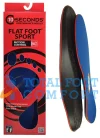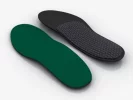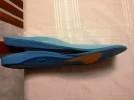Hiawatha
Active Member
- Time of past OR future Camino
- St Jean Pied de Port - Finisterra 2017
GR70 France 2018
Via Francigena 2019
I have continued my quest to find the best inner sole for the Merrell Moabs I wear for most training walks .
Previously I found that Steel Blue inner soles were comfortable and of good quality ,after a hundred odd kilometres they were still comfortable but I thought that there must be something just a little better available .
I have now tested six different brands of inner soles available here in Australia , all prices are in approximate Australian dollars , each pair of inner soles were used for at least 100km in similar conditions and over the same terrain .
Some photographs are of new, unused examples , most after the testing was over .
The candidates ,
Nike Runfast , a replacement inner for running shoes , no arch support , minimal cushioning . Manufactured from a resilient foam with a tough upper layer that resists bunching . Aprox. $12 aus.
These photographed are new unused ones , I have another pair in old runners at home .
Conclusion , lightweight , tough , suitable for running and not much else .
Would I wear them on a long distance walk ? not on your Nelly
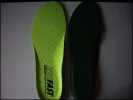

Oliver ComfortCushion , essentially a work boot inner sole , reasonable arch support , cushioning under ball and heel with sorbithane inserts . Made from a closed cell foam with ventilation perforations , top layer is tough and non slip . Aprox. $12/16 aus .
Conclusion , lightweight , tough , well ventilated , comfortable when standing , could be thicker .
Would I wear them on a long walk? , yes if there was no alternative , they would probably be suitable , just .
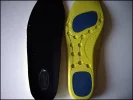
Steel Blue Ortho Rebound , another work boot inner sole , tough with excellent anti fungal properties and good ventilation, a heavy inner sole . Arch support adequate , resilience very good , top layer has anti slip areas . Aprox. $16/20 aus
Conclusion , tough ,comfortable very well ventilated so suitable for hot days , the waffled profile at the base accommodates any sand that enters the shoe so emptying out the day's accumulation can be delayed .
Would I wear them ? Yes , some inadequacies with ball cushioning though .
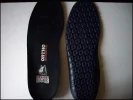
Spenco PolySorb, a cross training inner sole , multiple layers , superior arch support , a claimed low friction top cloth . Aprox. $45 aus .
Conclusion , the best in terms of rigid arch support , cushioning is really only adequate . A major flaw developed within the first twenty kilometres of use , the ' low friction ' top cloth came loose , bunching up and causing much irritation. A shame really as they were not bad otherwise .
Would I wear them ? No , not unless the top layer could be guaranteed to not peel off on the next pair .
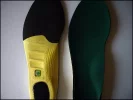
DR Comfort , a dual layer inner sole with gel inserts , available from podiatrists . Top layer is of a suede material , good arch support , good ball of foot and heel cushioning . Aprox.$50 aus
Conclusion, certainly comfortable and supportive , the gel inserts are well placed especially under the Hallux [ big toe joint ] ex football players may appreciate this . Some reservations on the durability of the suede top cloth, some wear was noted although there were no signs of separation during the test .
Would I wear them ? Yes , with no hesitation .

Neat Feat, , made from a single foam injection of Ultrabound plastic with a plastazote self moulding top cover . Arch support almost as good as Spenco, ball of foot and heel cushioning excellent. Thicker than some so the shoe must be able to accommodate the extra bulk . Aprox $36 aus .
Conclusion, without question the very best tested , resilient foam and moulded top cover combine to give superior support through the entire foot . No wear or compression noted , the pair photographed are new , the ones I am using at the moment securely fitted to my Merrells .
Would I wear them on the Camino ? Of course .
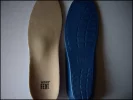
Previously I found that Steel Blue inner soles were comfortable and of good quality ,after a hundred odd kilometres they were still comfortable but I thought that there must be something just a little better available .
I have now tested six different brands of inner soles available here in Australia , all prices are in approximate Australian dollars , each pair of inner soles were used for at least 100km in similar conditions and over the same terrain .
Some photographs are of new, unused examples , most after the testing was over .
The candidates ,
Nike Runfast , a replacement inner for running shoes , no arch support , minimal cushioning . Manufactured from a resilient foam with a tough upper layer that resists bunching . Aprox. $12 aus.
These photographed are new unused ones , I have another pair in old runners at home .
Conclusion , lightweight , tough , suitable for running and not much else .
Would I wear them on a long distance walk ? not on your Nelly


Oliver ComfortCushion , essentially a work boot inner sole , reasonable arch support , cushioning under ball and heel with sorbithane inserts . Made from a closed cell foam with ventilation perforations , top layer is tough and non slip . Aprox. $12/16 aus .
Conclusion , lightweight , tough , well ventilated , comfortable when standing , could be thicker .
Would I wear them on a long walk? , yes if there was no alternative , they would probably be suitable , just .

Steel Blue Ortho Rebound , another work boot inner sole , tough with excellent anti fungal properties and good ventilation, a heavy inner sole . Arch support adequate , resilience very good , top layer has anti slip areas . Aprox. $16/20 aus
Conclusion , tough ,comfortable very well ventilated so suitable for hot days , the waffled profile at the base accommodates any sand that enters the shoe so emptying out the day's accumulation can be delayed .
Would I wear them ? Yes , some inadequacies with ball cushioning though .

Spenco PolySorb, a cross training inner sole , multiple layers , superior arch support , a claimed low friction top cloth . Aprox. $45 aus .
Conclusion , the best in terms of rigid arch support , cushioning is really only adequate . A major flaw developed within the first twenty kilometres of use , the ' low friction ' top cloth came loose , bunching up and causing much irritation. A shame really as they were not bad otherwise .
Would I wear them ? No , not unless the top layer could be guaranteed to not peel off on the next pair .

DR Comfort , a dual layer inner sole with gel inserts , available from podiatrists . Top layer is of a suede material , good arch support , good ball of foot and heel cushioning . Aprox.$50 aus
Conclusion, certainly comfortable and supportive , the gel inserts are well placed especially under the Hallux [ big toe joint ] ex football players may appreciate this . Some reservations on the durability of the suede top cloth, some wear was noted although there were no signs of separation during the test .
Would I wear them ? Yes , with no hesitation .

Neat Feat, , made from a single foam injection of Ultrabound plastic with a plastazote self moulding top cover . Arch support almost as good as Spenco, ball of foot and heel cushioning excellent. Thicker than some so the shoe must be able to accommodate the extra bulk . Aprox $36 aus .
Conclusion, without question the very best tested , resilient foam and moulded top cover combine to give superior support through the entire foot . No wear or compression noted , the pair photographed are new , the ones I am using at the moment securely fitted to my Merrells .
Would I wear them on the Camino ? Of course .







